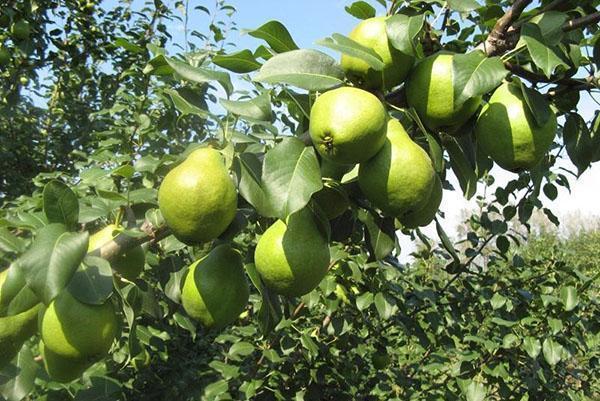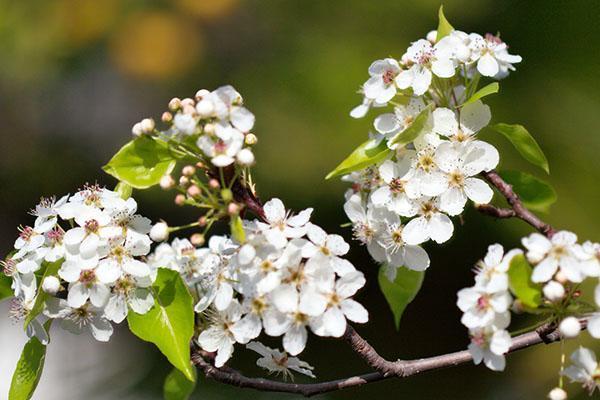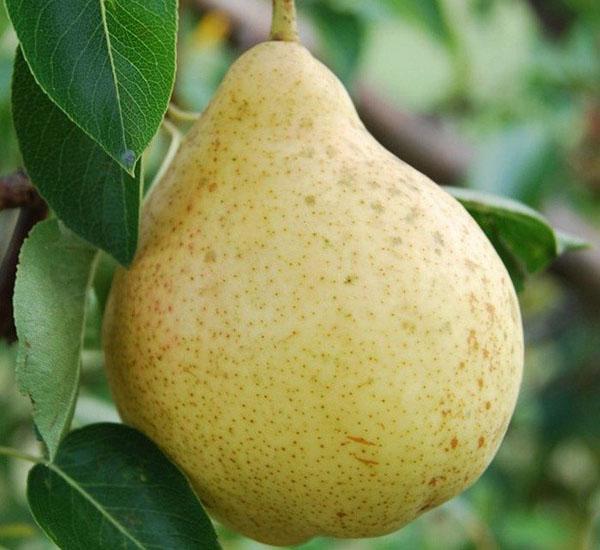The early-growing pear variety Moskvichka
 Pear Moskvichka description and photo, which can be found in the State Register of Varieties, is a fairly common variety of the autumn ripening period. It was bred at the Moscow Agricultural Academy using Kieffer pear seedlings. It is appreciated by gardeners for its early maturity and stable fruiting.
Pear Moskvichka description and photo, which can be found in the State Register of Varieties, is a fairly common variety of the autumn ripening period. It was bred at the Moscow Agricultural Academy using Kieffer pear seedlings. It is appreciated by gardeners for its early maturity and stable fruiting.
Description of the variety

This variety is characterized by medium-sized standard trees and a dense, medium-leafed crown. Most of the skeletal branches are upright with a slight slope. The bark on them is light gray. Shoots are medium in thickness and length, very often curved with internodes of medium length. The flowering period begins quite late.
 The Moskvichka pear variety is characterized by medium-sized, wide-pear-shaped fruits. Their color is green with a slight yellowish tinge with a large number of subcutaneous points. The pulp of the fruit is white and has an excellent dessert taste.
The Moskvichka pear variety is characterized by medium-sized, wide-pear-shaped fruits. Their color is green with a slight yellowish tinge with a large number of subcutaneous points. The pulp of the fruit is white and has an excellent dessert taste.
The pear harvest period is September. Signs of their ripeness are light yellowness on the skin. The shelf life of fruits at a temperature of about 0 ° can be up to 2-3 months. At room temperature, pears can be stored for no more than 15 days.
 The main advantages of the variety:
The main advantages of the variety:
- early maturity;
- annual fruiting;
- fairly high yield rates;
- good disease resistance.
Features and growing conditions
 Planting pears of the Moskvichka variety should be carried out in open, well-lit places. It does not impose special requirements on soils, but it develops and bears fruit best of all on fertile soils with a slightly acidic or neutral reaction.
Planting pears of the Moskvichka variety should be carried out in open, well-lit places. It does not impose special requirements on soils, but it develops and bears fruit best of all on fertile soils with a slightly acidic or neutral reaction.
A place for planting a pear seedling must have good drainage. Stagnant moisture is very detrimental to pear trees.
When laying a planting pit, 3-4 buckets of well-rotted manure, 1-1.5 superphosphate, about 600 g of calcium chloride and 2.5-3 kg of lime are necessarily introduced into it. In the first year after planting, in the absence of rain, the seedlings must be watered. For one tree, approximately 2-3 buckets of water are required.
Caring for the Moskvichka pear in the subsequent years of cultivation consists in the spring and autumn application of organic fertilizers once every 2 years. For these purposes, you can use humus or peat at the rate of half a bucket per square meter. For autumn application, fertilizers of the phosphorus-potassium group are used.
Of the features of growing Moskvichka, it is also worth noting its self-fertility. Therefore, pollinators must be planted next to it. The pollinator varieties for the Moskvichka pear are as follows:
- I love Yakovlev;
- Bergamot Moscow;
- Lada;
- Elegant Efimova.
Pests and diseases
 Pear, like any other culture, can be affected by various diseases or pests. The Moskvichka variety is characterized by high resistance to scab and fruit rot. However, in some years, their outbreaks can still be observed. Also of the most common pear diseases, the following should be noted:
Pear, like any other culture, can be affected by various diseases or pests. The Moskvichka variety is characterized by high resistance to scab and fruit rot. However, in some years, their outbreaks can still be observed. Also of the most common pear diseases, the following should be noted:
- septoriasis;
- rust;
- bacterial cancer.
To combat these diseases, special chemicals are used - fungicides. For example, you can use "Speed", "Bordeaux mixture", "Horus" and a number of others. For full protection of trees, it is recommended to carry out at least 3 complex treatments.
All chemicals should be diluted and applied according to the attached instructions. If the recommended dosage is exceeded, trees can get serious chemical burns.
Of the pests on pear trees, the following are most common:
- pear moth;
- leaf roll;
- green aphid;
- pear honeydew.
 For the destruction of all of the above pests, insecticidal preparations are used. For example, "Kinmiks", "Iskra", "Aktara". They should be applied according to the attached annotations.
For the destruction of all of the above pests, insecticidal preparations are used. For example, "Kinmiks", "Iskra", "Aktara". They should be applied according to the attached annotations.
Preventive measures play an important role in preventing the development of diseases and pests. Of the mandatory activities, it is especially worth noting the collection and destruction of worm-eaten volunteers, the autumn cleaning of branches and trunk from peeled bark, collection and burning of fallen leaves.
As can be seen from the description and photo, the Moskvichka pear is an unpretentious, consistently fruiting variety. Anyone can grow it on their site, the main thing is to choose a suitable place for planting and take appropriate care of the tree.